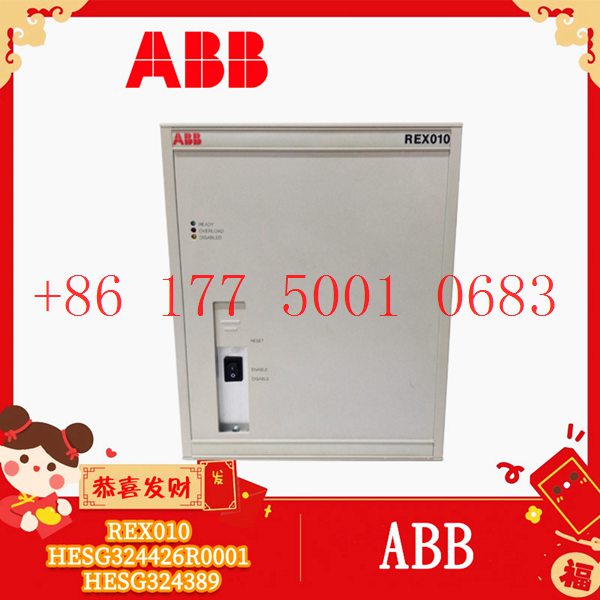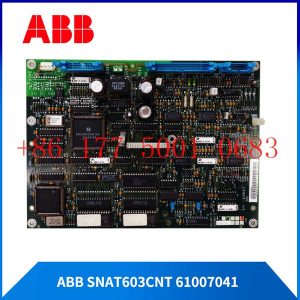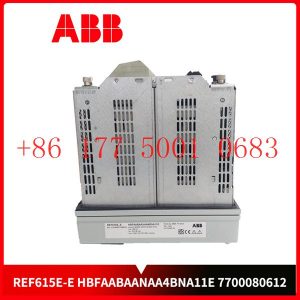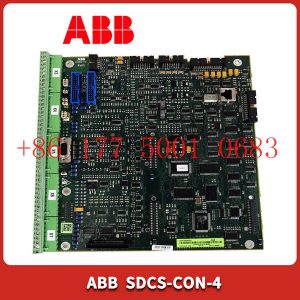Description
hardware flow control. It is an ideal choice in the field of industrial automation.
Implementation of communication between ABC industrial robot and PLC based on DeviceNet fieldbus technology
introduction
In modern production systems, industrial robots and PLCs need to communicate and collaborate to complete production tasks. That is, the
industrial robots output signals to the PLC, allowing the PLC to control related equipment to drive the robot”s front-end tools. This article
mainly analyzes the communication problems between ABB industrial robots and PLC based on DeviceNet fieldbus technology.
DeviceNet is a common network communication method in the field of automation. ABB industrial robots establish a network to communicate with
Siemens PLC based on the DeviceNet network.
1Configure DSQC652
There are mainly 5 types of standard I/0 boards commonly used in ABB industrial robots [2]. Except for the different addresses assigned to
them during setup, their configuration methods are basically the same. This article mainly analyzes the ABB standard I/0 board DS0C652, which
mainly builds communication modules based on the DeviceNet network. The DS0C652 board has a distributed I/O module with 16 digital input and 16
digital output interfaces. The board is installed in the ABB industrial robot control cabinet. First, define the specific operation steps of the DS0C652 board,
enter the teach pendant control panel, then enter the configuration menu (Figure 1), select the DeviceNetDevice menu, and add a template to enter Figure 2.
ABB standard I/0 board is hung on the DeviceNet
network, so the address of the module in the network must be set. The jumpers 6 to 12 of terminal x5 are used to determine the address of the module.
The available address range is 10 to 63. Modify the parameters in the template parameters to complete the DS0C652 board settings. Click the drop-down
menu to select the “Use value from template” row, select
“DS0C65224VDCI/0Device”, and then the parameters that need to be set include the address of the I/0 board in the bus.
Figure 1 Configuring DSQC652
2Configure signals and parameters
After completing the DS0C652 board setting, the I/0 signal setting will be performed. Setting the I/0 signal is the basis for establishing communication with
the PLC. The PLC communicates and transmits data with the ABB industrial robot through the I/0 signal and the DS0C652 board. As shown in Figure 3, in the
signal configuration interface, there are many default I/0 points after the system is established. Modification is not allowed. Click “Add” to add signals. When setting
input and output signals, their address range is 0~15. First, enter the signal menu in the configuration options to set the input and output types, and modify the corresponding parameters.
After completing the settings, the computer prompts that you need to restart the settings. If there are multiple signals that need to be defined and the waiting time
is long after restarting multiple times, you can click “Cancel” and wait for all signals to be defined before clicking the “Yes” button to restart. After the signal settings are
completed, click to select “Input and Output” in the ABB menu to check whether all signals have been set.
Figure 2 Configure DSQC652 parameters
Figure 3 Signal parameter settings
During the signal establishment process, attention should be paid to the DSoC652 port and PLC port addresses used, and the corresponding address table should be
established, as shown in Table 1. The robot interacts with the PLC through I/O signals. During the setting process, there must be no errors in the port and address number
of the PLC connected to the DSoC652. If the address is set incorrectly, the communication between the robot and the PLC will not work properly.
The entire robot teaching pendant setting process is shown in Figure 4.
Display operation panel 3HAC16784-1
Display operation panel 3HAC16783-1
Display operation panel 3HAC16782-1
Display operation panel 3HAC16780-5
Display operation panel 3HAC16780-1
Display operation panel 3HAC16704-7
Display operation panel 3HAC16704-1
Display operation panel 3HAC1670-1
Display operation panel 3HAC16672-1
Display operation panel 3HAC16628-3
Display operation panel 3HAC16627-3
Display operation panel 3HAC16626-3
Display operation panel 3HAC16626-2
Display operation panel 3HAC16527-1
Display operation panel 3HAC16416-1
Display operation panel 3HAC16403-1
Display operation panel 3HAC16402-1
Display operation panel 3HAC16331-1
Display operation panel 3HAC16328-1
Display operation panel 3HAC16327-1
Display operation panel 3HAC1629-3
Display operation panel 3HAC16226-1
Display operation panel 3HAC16202-1
Display operation panel 3HAC1618-1
Display operation panel 3HAC16037-1
Display operation panel 3HAC16032-3
Display operation panel 3HAC16014-1/05
Display operation panel 3HAC15999-1
Display operation panel 3HAC15988-1
Display operation panel 3HAC15944-1
Display operation panel 3HAC15879-3
Display operation panel 3HAC15860-1
Display operation panel 3HAC15803-1
Display operation panel 3HAC15734-1
Display operation panel 3HAC15732-1
Display operation panel 3HAC15722-1
Display operation panel 3HAC15716-1
Display operation panel 3HAC15661-7
Display operation panel 3HAC15661-2
Display operation panel 3HAC15625-6
Display operation panel 3HAC15625-5
Display operation panel 3HAC15625-2
Display operation panel 3HAC15607-1
Display operation panel 3HAC15571-3
Display operation panel 3HAC15571-2
Display operation panel 3HAC15534-1
Display operation panel 3HAC15495-1
Display operation panel 3HAC15492-1
Display operation panel 3HAC15443-1
Display operation panel 3HAC15433-1
Display operation panel 3HAC15423-1
Display operation panel 3HAC15389-1
Display operation panel 3HAC15385-1
Display operation panel 3HAC15377-1
Display operation panel 3HAC1537-1
Display operation panel 3HAC15365-1
Display operation panel 3HAC1535-1
Display operation panel 3HAC15309-2
Display operation panel 3HAC15158-3
Display operation panel 3HAC15038-1
Display operation panel 3HAC14959-5
Display operation panel 3HAC14947-1
Display operation panel 3HAC14819-1
Display operation panel 3HAC14691-1
Display operation panel 3HAC14682-2
Display operation panel 3HAC14682-1
Display operation panel 3HAC14673-2
Display operation panel 3HAC1466-2
Display operation panel 3HAC14659-2
Display operation panel 3HAC14551-2
Display operation panel 3HAC14550-4/04B
Display operation panel 3HAC14550-2/09A
Display operation panel 3HAC14550-2/09A
Display operation panel 3HAC14550-2/03A
Display operation panel 3HAC14549-3
Display operation panel 3HAC14549-1/11A
Display operation panel 3HAC14546-4








Reviews
There are no reviews yet.